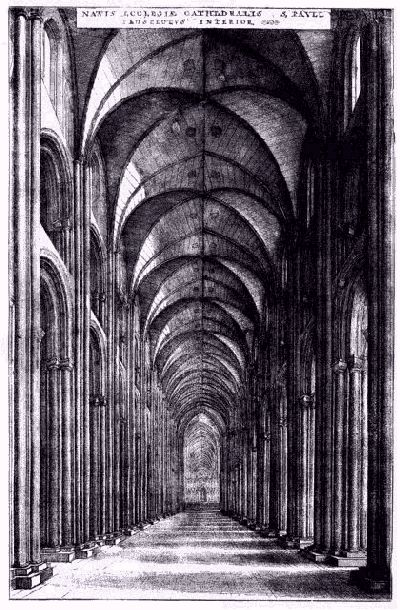The statue of Our Lady of Grace by the Pillar in St Paul’s appears to have left little trace in accessible sources. Images of Our Lady of Grace are ones which are held to be conveyors of Divine Grace and blessing to those who pray before them.
The following note is from William Benham Old St Paul’s Cathedral (1902) as he describes the nave of this great lost building:
The next monument has a very strange and quaint interest. It was nearly opposite Kempe's, in the eleventh bay on the south side, that of Sir John Beauchamp, of Powick, in Worcestershire (son of Guy, Earl of Warwick), who died in 1374. He settled, out of some tenements in Aldermanbury, for the payment of 10 marks a year for a priest to celebrate at his altar, and 50s. a year for the special keeping of the anniversary of his death, December 3rd. There was a very fine image of the B.V.M. beside this tomb. Barnet, Bishop of Bath and Wells, gave a water mill, ninety acres of arable and pasture, and eight acres of wood, all lying at Navestock, in Essex, to the Dean and Chapter for the saying of certain prayers and a de profundis beside this image for the souls of the faithful; and there were constant oblations here. John Westyard, citizen and vintner, founded another altar at the same place for a chantry priest to say masses for the soul of Thomas Stowe, sometime Dean of St. Paul's, and for those of his parents and benefactors. In after years a strange mistake befell this tomb, one wonders why. It became popularly known as the tomb of Duke Humphrey, of whom we have more to say hereafter, who was buried not here but at St. Albans.
The Bishop of Bath and Wells must be John Barnet, who held the See between 1363 and 1366, when he presumably made the gift of the Navestock property. A former prebendary of the cathedral he was consecrated in St Paul’s as Bishop of Worcester in 1362, became Bishop of Ely in 1366 and Lord Treasurer, dying in 1373. There is an account of his life at Barnet, John (d. 1373), bishop of Ely

The nave of St Paul’s by Wenceslaus Hollar.
The statue would have been at the far end of the nave on the right
Image: Project Gutenberg
[page 15]to the Dean and Chapter for the saying of certain prayers and a de profundis beside this image for the souls of the faithful; and there were constant oblations here. John Westyard, citizen and vintner, founded another altar at the same place for a chantry priest to say masses for the soul of Thomas Stowe, sometime Dean of St. Paul's, and for those of his parents and benefactors. In after years a strange mistake befell this tomb, one wonders why. It became popularly known as the tomb of Duke Humphrey, of whom we have more to say hereafter, who was buried not here but at St. Albans.
[page 15]to the Dean and Chapter for the saying of certain prayers and a de profundis beside this image for the souls of the faithful; and there were constant oblations here. John Westyard, citizen and vintner, founded another altar at the same place for a chantry priest to say masses for the soul of Thomas Stowe, sometime Dean of St. Paul's, and for those of his parents and benefactors. In after years a strange mistake befell this tomb, one wonders why. It became popularly known as the tomb of Duke Humphrey, of whom we have more to say hereafter, who was buried not here but at St. Albans.

No comments:
Post a Comment